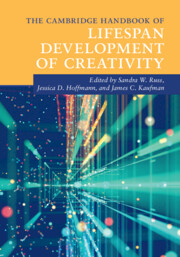Book contents
- The Cambridge Handbook of Lifespan Development of Creativity
- The Cambridge Handbook of Lifespan Development of Creativity
- Copyright page
- Dedication
- Contents
- Figures
- Tables
- Contributors
- Acknowledgments
- Introduction
- Part I Core Concepts of Lifespan Creativity Development
- Part II The Development of Creativity
- Part III Modes of Enhancement
- Part IV Environments and Contexts
- 18 Creative Identity Development in Classrooms
- 19 Creativity in Children’s Museums
- 20 Makers and Makerspaces
- 21 Organizations and Creativity
- 22 Creativity Development and Culture
- Part V Special Populations
- Index
- References
18 - Creative Identity Development in Classrooms
from Part IV - Environments and Contexts
Published online by Cambridge University Press: 19 November 2021
- The Cambridge Handbook of Lifespan Development of Creativity
- The Cambridge Handbook of Lifespan Development of Creativity
- Copyright page
- Dedication
- Contents
- Figures
- Tables
- Contributors
- Acknowledgments
- Introduction
- Part I Core Concepts of Lifespan Creativity Development
- Part II The Development of Creativity
- Part III Modes of Enhancement
- Part IV Environments and Contexts
- 18 Creative Identity Development in Classrooms
- 19 Creativity in Children’s Museums
- 20 Makers and Makerspaces
- 21 Organizations and Creativity
- 22 Creativity Development and Culture
- Part V Special Populations
- Index
- References
Summary
Outside of the home environment, classrooms represent one of the most persistent and frequented settings where young people spend their time. Classrooms thereby hold much potential for creative identity development. “Creative identity development” refers here to the crystallization of creative interests (“I like writing short stories”) and aspiration (“I want to be short story writer”) into more stable beliefs about one’s broader identity (“I am a creative short story writer”) and sense of self (Beghetto, 2013; Beghetto & Dilley, 2016). Given that some young people also go on to become teachers, classrooms represent a site where adults can continue to develop and express their creativity in the domain of teaching (Beghetto, 2017). How then might school and classroom experiences support students’ and teachers’ creative identity development? The purpose of this chapter is to provide an overview of factors involved in creative identity development.
Keywords
- Type
- Chapter
- Information
- The Cambridge Handbook of Lifespan Development of Creativity , pp. 395 - 414Publisher: Cambridge University PressPrint publication year: 2021
References
- 1
- Cited by



